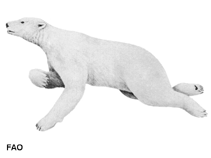Ursus maritimus Phipps, 1774
Polar bear
Classification / Names Common names | Synonyms | CoL | ITIS | WoRMS
Mammalia | Carnivora | Ursidae
Environment: milieu / climate zone / depth range / distribution range Ecology
Demersal. Polar
Distribution Countries | FAO areas | Ecosystems | Occurrences | Introductions
Atlantic Ocean and the Arctic: Ursus maritimus maritimus: Canada, Northwest Territories, Baffin Island, Greenland, Svalbard, Russia, Labrador, Newfoundland, Quebec, Iceland, Norway; Ursus maritimus marinus: Russia, Beaufort Sea, Alaska, Bering Sea, Kamchatka, Kuril Island, Sea of Okhotsk, Japan (Ref. 1522).
Length at first maturity / Size / Weight / Age
Maturity: Lm ? range ? - ? cm Max length : 250 cm TL male/unsexed; (Ref. 1394); 200 cm TL (female); max. published weight: 800.0 kg (Ref. 1394); max. published weight: 800.0 kg
Short description Morphology
Life cycle and mating behavior Maturity | Reproduction | Spawning | Eggs | Fecundity | Larvae
Main reference
References | Coordinator | Collaborators
Jefferson, T.A., S. Leatherwood and M.A. Webber 1993 FAO species Identification Guide: Marine Mammals of the World. Rome, FAO. 320 p. + 587 figures. (Ref. 1394)
IUCN Red List Status
(Ref. 130435: Version 2025-1)
CITES status (Ref. 108899)
CMS (Ref. 116361)
Threat to humans
Human uses
Fisheries: commercial
FAO - Fisheries: species profile | FishSource | Sea Around Us
Tools
More information
Max. ages / sizes
Length-weight rel.
Length-length rel.
Length-frequencies
Mass conversion
Abundance
Internet sources
BHL | BOLD Systems | CISTI | DiscoverLife | FAO(Fisheries: species profile; publication : search) | Fishipedia | GenBank (genome, nucleotide) | GloBI | Gomexsi | Google Books | Google Scholar | Google | PubMed | Tree of Life | Wikipedia (Go, Search) | Zoological Record



